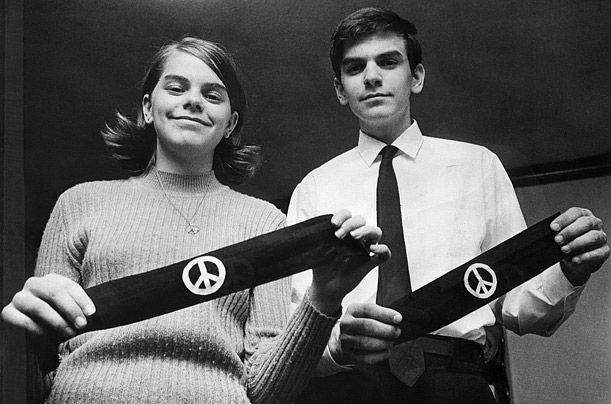Below is my paper:
 |
Mary Beth Tinker and John Tinker, (1954), SCOTUSblog.com
|
Mary Beth Tinker, the plaintiff of Tinker v. Des Moines argued that her suspension due to their silent protest was a violation of her 1st and 14th amendment rights. Des Moines Independent Community School District, the defendant of the case argued that the protest disrupted students during class. The Supreme Court ruled 7-2 stating that the first amendment applied to every situation and that school official couldn’t censor speech unless it disrupted the class. Wearing a black armband wasn’t disruptive, therefore the court held that the first amendment protected the student's rights. Justice Abe Fortas wrote the majority opinions: “ It can hardly be argued that either students or teachers shed their constitutional rights to freedom of speech or expression at the schoolhouse gate.”The ruling of Tinker v Des Moines is just, the first amendment states:”Congress shall make no law respecting an establishment of religion, or prohibiting the free exercise thereof; or abridging the freedom of speech, or of the press, or the right of the people peaceably to assemble...” The first amendment plays a big factor in the Tinker v Des Moines case, without the first amendment Mary, John and Chris would have been suspended without any justifications.
The ruling of this case affected how our school system is run today; it may have given students freedom, but it also set some limitations on freedom and expression. There has been a numerous of cases that challenge the freedom of expression school groundsnd, for example, the Layshock v. Hermitage case. A student in the Hermitage district was suspended for using vulgar language about her principal on Facebook. Although the words used were offensive and vulgar, the court ruled in favor of the student claiming that punishing students off school ground violates the first amendment(Prezi.com). Because of the Tinker rulings, students have been expressing themselves more freely through their attire. Most schools now allow nose rings and dyed hair but disallow offensive attire such as a t-shirt with a Confederate flag. June of 2002, the Supreme Court ruled that schools can limit student speech that advocates illegal drug use. Concerning a case when Joseph Fedrick, a senior at Juneau-Douglas High School who was suspended for having a banner that said,” Bong Hits 4 Jesus” around school grounds(New York Times). The Tinker v. Des Moines brought a term called, in loco parentis, which means in place for parents in Latin. In loco parentis means that school officials can act as your parents on school ground by disciplining the student if it is disruptive.
The Tinker v. Des Moines case allowed students to express themselves, whether it be a political movement or as small as an article of clothing. It allowed for the constitution to override what the school officials deemed to be disruptive to the class. The ruling gave power to the 3 students voice for the protest against the Vietnam War and allowed them to make a change in the world.
Citations:
The New York Times. The New York Times. Web. 28 May 2017.
Constitute. Web. 28 May 2017.
Johnson, John W. The Struggle for Student Rights: Tinker v. Des Moines and the 1960s. Lawrence, Kan.: U of Kansas, 1997. Print.
Leski, Joanna. "How Did the Tinker vs. Des Moines Decision Affect Student Speech?" Prezi.com. 30 Jan. 2013. Web. 28 May 2017.
"Tinker v. Des Moines - Landmark Supreme Court Ruling on Behalf of Student Expression." American Civil Liberties Union. Web. 28 May 2017.